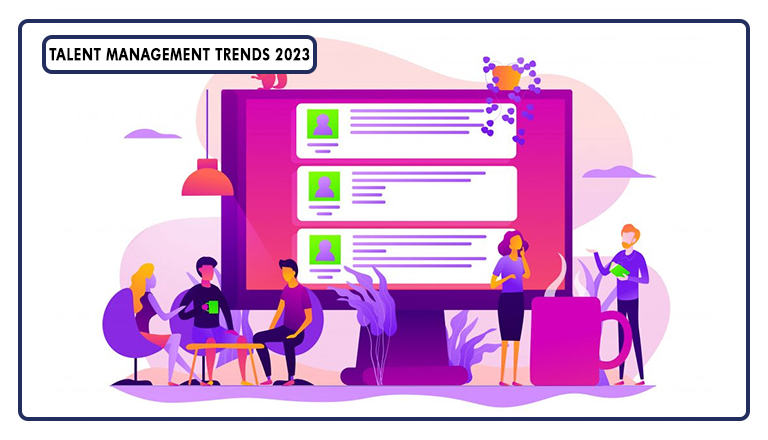As 2023 begins, carrying the aftereffects of the Great Resignation, the emotional weight of the return to the office post-COVID, and the looming shadow of an anticipated recession, HR professionals worldwide are bracing themselves for a workplace of a different dynamic. The trends this year show talent management strategies that are more attuned to the new shape of the workforce and its rising sentiments.
In this article, we explore the most striking features of the new shape of the workforce and how HR professionals worldwide are adapting their talent management strategies this year to thrive in a relentlessly changing landscape.

The Face of the Workforce of 2023
The 47 million resignations that marked ‘The Great Resignation’ and the 64% of employees reporting they would leave their employers if forced to return to the office full-time are but symptoms of a changing dynamic. The power imbalance between employers and employees is shifting, giving more agency to employees. This new power structure is driven by the below forces.
1). Scarcity in Specialized Talent
According to a Korn Ferry report, by 2030, more than 85 million jobs could go unfilled because there won’t be enough skilled people to take them. And according to the World Economic Forum, 50% of employees will need re-skilling to meet tech changes by 2025. So, organizations are having a hard time hiring highly specialized talent today and, what’s even worse, it won’t get any better in the future. This trend of scarcity in specialized talent has not gone unnoticed by the workforce. This is why skilled employees know they are hard to find and are putting in the effort to re-negotiate the social contract of work.
2). A Much Better Informed Workforce
In the good old days, employers could maintain salary and career trajectory confidentiality, now this confidentiality is a thing of the past. With the huge amount of data available on job boards, professional networking platforms, salary comparison websites, etc., and with the open sharing of cross-generational career experiences on social media platforms, the workforce of today is a much better-informed talent group. They are aware of their industry average compensation, their skill benchmarks, and the reputations of potential employers. In a nutshell, they have at their fingertips access to information that they can effectively use to negotiate better compensation and career growth opportunities for themselves.
3). A Workforce with Different Priorities
Research by PwC shows that when asked to rank what matters the most in their current jobs, ‘meaning in day-to-day work’ aka. ‘purpose’ tops the ranks of 83% of surveyed employees. Moreover, in a survey done by McKinsey, flexible work arrangements have been listed as one of the top priorities of employees when deciding to join an organization. With this new focus on purpose and well-being, organizations must adapt their employee experiences and employer value propositions to rise to the new priorities of the modern workforce.
4). A New Employer-Employee Relationship
The open and transparent access to information and opportunity has led to a shift in the nature of the employer-employee relationship. It is no longer a long-term exclusive relationship as it used to be. With 50% of millennials and 70% of Gen Zs reporting having side hustles alongside their full-time jobs and with the average number of years that employees spend in the same organization falling down to 4.3 years, employers must expect a more transient, non-exclusive relationship with employees, especially highly specialized talent. Only organizations that can adjust to these shifting dynamics will succeed in attracting and retaining the right talent.
5). The Rise of the Contingent Worker
Along the same lines, employers must also be open to tapping into the hidden talent of the contingent workforce to fulfill their talent needs. Getting contingent workers on board is no longer going to be an exception, but the rule, with experts recommending a 70/30 split between FTEs and contingent employees in your organization. Contingent workers are highly skilled professionals who work freelance or on a project basis to enjoy the flexibility and freedom that comes with contingent work. Therefore, if you want to succeed with this workforce, you must adjust your talent management strategy to accommodate their priorities.
6). The Boundaryless Organization
With the end of the pandemic, more organizations are inviting employees back to the office. However, research shows that 64% of employees would leave their organizations if a hybrid option is not available. With these clear employee priorities, companies like Shopify and Buffer are now flaunting work-from-anywhere-anytime work arrangements and 63% of high-growth organizations are already offering their employees hybrid work options. In the past years, many efforts have been made to maintain employee productivity within the new boundaryless organization. This year, the focus is on how to do it while building and maintaining the organizational culture and office friendships. Many organizations are experimenting with many solutions to discover what works.

How Talent Management is Responding
With this new face of the workforce in 2023, the organizations that are ahead of the curve are revisiting their talent management strategies and re-adjusting them to meet the demands of a new workforce dynamic. Here are some of the biggest changes that these organizations are making.
1). Flexible Talent Acquisition
Talent acquisition is getting more flexible as rivalry on attracting highly specialized talent and skilled professionals brews. Organizations are offering more roles on a contingent basis and are tapping into the global workforce. In fact, the Staffing Industry Analysts (SIA) reported in 2021 that there are 52 million contingent workers in the U.S. alone, representing 35% of the talent force. Moreover, talent acquisition is focused on re-designing the employer value proposition to offer higher, more equitable compensation and benefits, more flexible and hybrid work arrangements, employee experiences focused on wellbeing, and career development and growth opportunities.
2). A Focus on Re-Skilling & Up-Skilling
With the skill shortages of today and the future, organizations are directing their learning and development strategies toward re-skilling and up-skilling employees. In fact, research by Gartner shows that this is a top priority for 42% of HR leaders amidst fears that they may not have an explicit ‘future of work’ strategy.
3). A Focus on Career Growth
With a recent Gallup poll finding that 50% of the US workforce is ‘quiet quitting’ and the trend topping social media charts, organizations are making the shift this year to discover the true talent of their employees and re-focus on their growth and development. Talent management professionals are this year exploring ways to increase employee engagement on the job by making current work challenging and charting career paths for employees.
4). Employee Experience Front & Center
With the rising skill shortages and the new priorities of the workforce, organizations that will thrive are the ones that are re-centering the employee experience around the well-being of their employees. Creating meaningful, purposeful work, supporting work-life integration, and providing opportunities for impact are all key talent management objectives this year. Organizations that thrive are the ones that will prioritize human outcomes.
5). Making Hybrid Work
As more organizations go remote or hybrid, the question most talent management functions are now exploring is how to do it while maintaining organizational culture. Organizations are exploring myriad practices such as third-party workplaces, office-day events, regular check-ins, etc. to make hybrid work for company culture. Moreover, talent professionals, this year, are also concerned with performance visibility. In other words, in a workplace where some employees come to the office while others mostly work from home, how can organizations make sure the contributions of the remote workforce remain visible and do not go understated?
6). Rebuilding the Future Leaders
This new dynamic in the employer-employee relationship puts great demand on the skillset of leaders across organizations. The traditional approach to management and leadership will no longer make the cut. The new leader needs to be more experimental, work with more influence than power, motivate with purpose, and lead a remote, diverse team. With all these rising demands, 24% of HR leaders express that they are concerned about their leaders’ ability to adjust and 60% of HR leaders have listed leadership development as their top priority for 2023.
Prepare Your Talent Management Strategy for 2023
These have been the driving forces shaping the new face of the workforce in 2023 and the top talent management trends responding to them. If you’re interested in digitizing your talent management experience, you can check out our talent management solutions here. And if you’re interested in exploring ways to rebuild your leaders and upskill your workforce, you can check out our learning solutions here.

